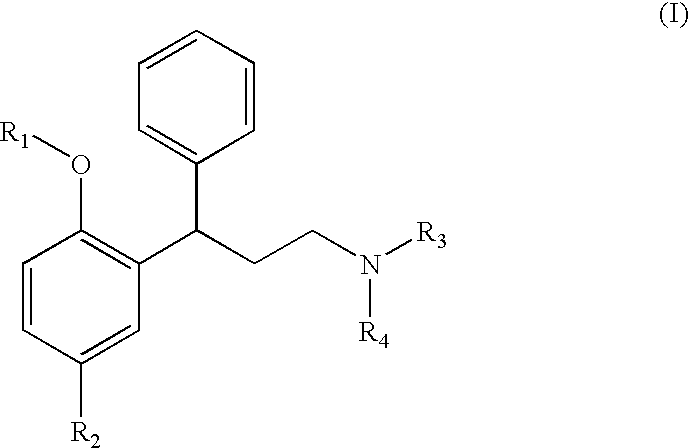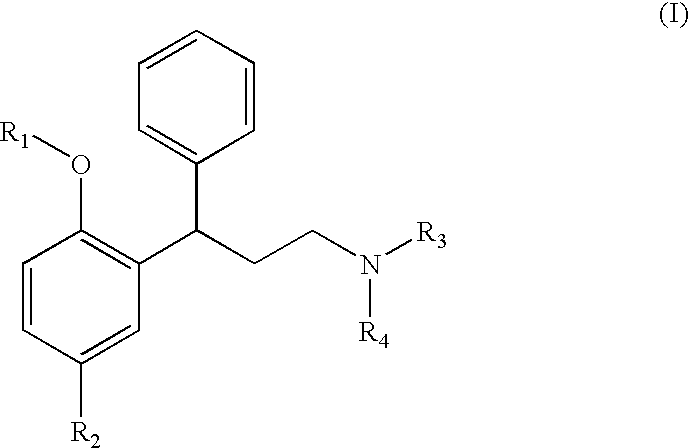Method of obtaining 3,3-diphenylpropylamines
a technology of phenylpropylamine and phenylpropylamine, which is applied in the field of obtaining 3, 3-diphenylpropylamines, can solve the problems of high cost of reagents such as methyl iodide or lithium aluminium hydride, high cost of reagents, and high risk of use, and achieves simple steps, reduced number of synthetic steps, and high yield
- Summary
- Abstract
- Description
- Claims
- Application Information
AI Technical Summary
Benefits of technology
Problems solved by technology
Method used
Image
Examples
example 1
Obtaining N,N′-diisopropyl-3-phenyl-2-propenamine [Compound of Formula (II) wherein R3 and R4 are isopropyl]
A) From Cinnamyl Bromide
[0123]A solution of 10 g of cinnamyl bromide (0.05 moles, 1 equivalent) in 10 ml of ethanol is added, in a one hour interval, to a solution of 28.5 ml of diisopropylamine (0.2 moles, 4 equivalents) in 30 ml of ethanol heated at 30° C. After approximately one hour, the reaction is considered to be finished and the solvent and remains of diisopropylamine are removed by distillation at reduced pressure. 100 ml of toluene and 150 ml of water are incorporated to the residue and concentrated HCl is added until a pH between 1 and 2, the phases are separated; the aqueous phase is basified by adding sodium hydroxide until a pH between 10 and 11, is extracted 150 ml of heptane and washed with water. The organic extract is subjected to distillation at reduced pressure to give rise to an oil weighing 8.6 g (90% yield) corresponding to the product of the title.
[0124...
example 2
Obtaining N,N-diisopropyl-3-(2-hydroxy-5-methylphenyl)-3-phenylpropylamine [Compound of Formula (I) wherein R1 is hydrogen, R2 is methyl and R3 and R4 are isopropyl]
A) Using Aqueous Hydrobromic Acid (aq BrH) / Acetic Acid (AcOH)
[0127]5 g of N,N-diisopropyl-3-phenyl-2-propenamine (0.023 moles, 1 equivalent) and 6 g of p-cresol (0.055 moles, 2.4 equivalents) are incorporated to a solution of 13 ml of acetic acid. 15 ml of 48% HBr in water is added to the solution formed and it is heated until the reflux temperature. Once the reaction has ended, it is cooled and the solid formed is filtered, washing it with water. The obtained solid forms N,N-diisopropyl-3-(2-hydroxy-5-methylphenyl)-3-phenylpropylamine (tolterodine) in the form of raw hydrobromide, which can be recrystallized in ethanol, methanol or isopropanol to give purified N,N-diisopropyl-3-(2-hydroxy-5-methylphenyl)-3-phenylpropylamine hydrobromide.
[0128]Obtained amount of raw N,N-diisopropyl-3-(2-hydroxy-5-methylphenyl)-3-phenylpr...
example 3
Obtaining N,N-diisopropyl-3-(2-methoxy-5-methylphenyl)-3-phenylpropylamine [Compound of Formula (I) wherein R1 and R2 are methyl and R3 and R4 are isopropyl]
A) Using AlCl3
[0132]8 ml of anisole (0.065 moles, 8.2 equivalents) and 2 g of N,N-diisopropyl-3-phenyl-2-propenamine hydrochloride and incorporated to a 50 ml flask. 2.1 g of AlCl3 (0.0157 moles, 2 equivalents) are added to the cooled reaction mixture, taking care of the exothermy, without the temperature exceeding 40° C. The obtained suspension is heated until reaching 40° C. and is maintained in this way for 15-30 hours, until the reaction is considered to be finished. The majority presence of N,N-diisopropyl-3-(2-methoxy-5-methylphenyl)-3-phenylpropylamine together with N,N-diisopropyl-3-(2-hydroxy-5-methylphenyl)-3-phenylpropylamine as the main impurity is observed by high performance liquid chromatography (HPLC). The reaction mixture is treated by adding 60 ml of water and extracting with 100 ml of dichloromethane. Another...
PUM
| Property | Measurement | Unit |
|---|---|---|
| temperature | aaaaa | aaaaa |
| temperature | aaaaa | aaaaa |
| temperature | aaaaa | aaaaa |
Abstract
Description
Claims
Application Information
 Login to View More
Login to View More - R&D
- Intellectual Property
- Life Sciences
- Materials
- Tech Scout
- Unparalleled Data Quality
- Higher Quality Content
- 60% Fewer Hallucinations
Browse by: Latest US Patents, China's latest patents, Technical Efficacy Thesaurus, Application Domain, Technology Topic, Popular Technical Reports.
© 2025 PatSnap. All rights reserved.Legal|Privacy policy|Modern Slavery Act Transparency Statement|Sitemap|About US| Contact US: help@patsnap.com



